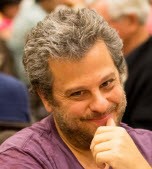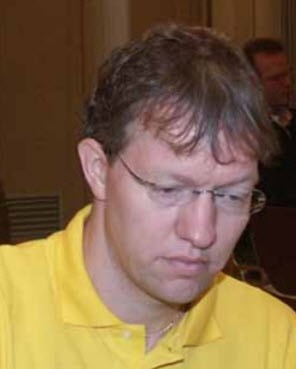Marc Smith visits the qualifying rounds of the OCBL July Cup
Sixteen teams began the Online Contract Bridge League’s July Cup, with half of the field to qualify for the knockout stage at the end of the week-long event. In last week’s column, we saw the action from the first four matches, after which the leaderboard looked like this:
| BLACK | 63.32 VPs |
| SCHWARTZ | 53.89 |
| DONNER | 50.64 |
| HUNGARY | 45.75 |
| LESLIE | 44.74 |
| RIPPEY | 43.90 |
| MOSS | 42.39 |
| BRAIN GLUCOSE | 42.18 |
| PIGOT | 41.96 |
| FREDIN | 40.75 |
It is a testament to the overcall quality of the field that the original #1 seeds, GILLIS (Scotland/Norway) and #3 seeds, HARRIS (England/Bulgaria) were lying twelfth and fourteenth respectively in the 16-team field. There is plenty of bridge yet to be played, though, as we are only just approaching the midway point of the qualification stage.
As usual, we begin with some problems, and we shall discover later how your choices would have worked. First, with just the opponents vulnerable, you are West with:
What action do you take?
Next, with both sides vulnerable, you hold as North:
What action, if any, do you take?
Next, an opening lead problem for you. You are North and hear the following auction:
What do you lead?
Finally, with neither side vulnerable, you are North holding:
What do you bid?
I’ll leave you to mull those over and press on with the action. Despite a loss in Round 4 that dropped them down to fifth place, LESLIE (England) find themselves facing the leaders, BLACK (England/Sweden) in Round 5. Meanwhile, second-placed SCHWARTZ (USA) plays BRAIN GLUCOSE (USA/Italy/England) in a match that pits the Grossack brothers against each other. BLACK led 36-10 at the midway point, whilst SCWARTZ trailed 10-13 in the other match, so the gap at the top of the leaderboard was quickly widening. All four North/South pairs had a chance to go plus on the first deal of the second half, but only one found a winning defence:
Two identical auctions left North on lead against 5♦ in the BLACK-v-LESLIE match. Andrew Black led the ♠A, got the ♠9 (standard count) from South, and tried to give his partner a spade ruff at trick two. With dummy’s spade honours established for a heart discard, declarer now had eleven tricks: E/W +600.
In the other room, Mike Bell kept defensive hopes alive when he tabled the ♣10 at trick one. Concluding that the best chance was that his partner held the singleton club, Ben Norton overtook with the ♣J and tried to cash the ♣A. Declarer ruffed and was soon claiming: E/W +600 and a flat board. LESLIE won the second half 29-21, but that was still another comfortable victory for BLACK, pulling away now.
The general style these days is for everyone to get into the auction at the sniff of an oil rag. It is perhaps surprising, therefore, that Italy’s Massimiliano Di Franco was the only North player to open the ‘obvious’ weak two in spades at favourable vulnerability, but that did not change the contract:

Twice a silver medallist as a junior, in 2009 at the World Youth Congress and at the 2011 European Youth Team Championships, Massimiliano Di Franco won the Open Teams at the European Champions Cup in both 2014 and 2015. He kicked off the defence with the ♣10, which was allowed to win the trick. Andrea Manno also won silver medals as a junior at both World and European championships, but a couple of years after his current partner. He followed with the ♣3 at trick one, perhaps count-showing, perhaps suit-preference. Whatever it meant, Di Franco switched accurately to the ♥2 and the defenders could not then be denied their three tricks. E/W -100.

Would Vincent Demuy have done better to cover with dummy’s ♣K at trick one? Might South have then been persuaded to try to cash a second club? Even if not, the heart switch is even more difficult to find from the South seat.
A completely different scenario due to a variation in notrump range meant that a consierable number of IMPs swung on the opening lead at the fourth table:
Presumably influenced by Englishman Ewan McNay, the East hand did not fall into Zack Grossack’s range for a 1NT opening. The effect of his 1♣ opening was to silence South who, presumably, now had no way to show his strong seven-bagger. McNay made a natural pre-emptive jump response in diamonds but, opposite a partner who was vulnerable against not, Grossack still felt entitled to take a shot at game.
As opening leads go, the ♠9 would have been an inspired choice. Whether Schwartz would have won with the ♠A and switched to the ♣10, we will never know, but that is how the defenders could have taken the first eight tricks to leave declarer short by four, vulnerable undertricks. When, instead, Jenny Wolpert tabled the ♣ J, Grossack was able to claim a painless ten tricks: E/W +630 and an exciting 12 IMPs to BRAIN GLUCOSE.
It was the start of a good run that saw BRAIN GLUCOSE pull away to win the match 41-27. Despite the loss, SCHWARTZ remained in second place, but now almost 17 VPs behind the leaders.
In Round 6, it was the turn of DONNER to face the leaders, whilst SCHWARTZ took on fifth-placed HUNGARY. Many West players were faced with some variation of this week’s first bidding problem in this round:
There are numerous reasons why sacrificing in 5♦ could be wrong. When you have a trump void, it is not that rare for partner to have a sufficiently strong holding to seriously inconvenience declarer, making your save a phantom. Certainly, partner could have held a 3-4-4-2 shape on this auction. With such a poor hand, it is also perhaps possible that 5♦ could cost more than North/South’s game. Alternatively, it is a possibility that the opponents have stopped prematurely, and backing in may give them a second chance to bid a making slam – would that be classed as a grand Biltcliffe?
For whatever reason, Joe Grue opted to defend. With the opponents’ diamonds breaking 2-2, the defenders have three top winners but no more: N/S +620.
Gary Donner showed the North hand as an invitational or better four-card heart raise and Sandra Rimstedt bid game on the South cards. Nevertheless, Tom Paske was in a similar situation to Grue at the other table. The Englishman chose to save, and there were just three clubs and one spade to lose: N/S +300 and 9 IMPs to BLACK.
The BLACK bandwagon continues to roll right along: they defeat DONNER 39-16 and now lead the field by more than a match (20 VPs).

In the other key match, Miklos Dumbovic heard exactly the same auction as Grue, and he bid 5♦ on the West cards: N/S +300. American John Kranyak, three times a World junior champion representing the USA in the early 2000s, got to the same place but by a somewhat more imaginative route:
Again, N/S +300 for a flat board. SCHWARTZ won a close match, 25-22, but dropped down to third place. BRAIN GLUCOSE scored an impressive win, 48-19 over MOSS following a 39-0 first half whitewash, to move up into second spot. They take on the leaders in Round 7, whilst SCHWARTZ play DONNER.
There were three slam deals that created swings in one or both of the top matches, but it was Board 10, where everyone faced the second of this week’s bidding problems, that caught my eye.
Simon Hult opened 1NT and Gunnar Hallberg made what looks like a fairly routine pass. Zack Grossack then backed in with 2♣ having passed as Dealer and, although not alerted in the hand records, I assume this showed clubs and higher-ranking suit. McNay had no reason to move, as he expected his partner’s second suit to be diamonds. Hallberg probably inferred that East’s second suit was spades, so he might have balanced back in, but do you really want to push them into what could easily be a better fit?
Grossack won the trump lead in hand and advanced the ♠Q. South won with the ♠K to play a second trump, and declarer won and led a second spade. South won with the ♠A and delivered his partner’s spade ruff, but that left declarer with two spade winners to go with his six trumps tricks. The defence could have played a third round of trumps rather than taking the ruff, but declarer would still have eight black-suit winners (three spades and five clubs). E/W +90 looked like a good result for the Anglo-American pair.
Massimiliano Di Franco decided that he liked his hand, indeed he like it a lot: not only did he Stayman, but he then raised the 2♥ response to game, And not a bad game it turned out to be, as the hands fit remarkably well. David Gold led his singleton diamond, declarer winning in dummy with the jack. When Andrea Manno, not unreasonably, cashed the ♥K and followed with a heart to dummy’s ace, though, he was in trouble. A diamond to the queen came next, ruffed by West with the ♥6. Gold cashed the ♣A and continued the suit, and the defence still had the ♥Q to come: E/W -100 and flat board.
In the other top match, one declarer was left to play undisturbed:
Schwartz forewent the opportunity to use Stayman and neither opponent saw any reason to disturb South’s opening bid. Cecilia Rimstedt found her side’s longest suit with her opening lead, a spade. Declarer won in hand, crossed to the ♥A, and took the diamond finesse. When that was successful, she had nine tricks. E/W -150.

Like the Italian North in the other match, Brad Moss also rolled out Stayman. He followed only with an invitation raise of the 2♥ response, but Joe Grue carried on to game. After a clearly limited auction, John Kranyak was thus tempted to double on shape and expected poor breaks on the way out.
Here, too, West opened the ♦2, and Grue won in hand with the ♦Q. Unfortunately for the defenders, East’s double had given declarer a virtual blueprint of the distribution. Grue cashed the ♥K and ran the ♥10. East’s discard meant that declarer had to draw all of the trumps before repeating the diamond finesse but West, as expected, had not led away from ♦K-x-x. Declarer was able to claim five diamonds, four hearts and two spades: E/W -990 and a massive 13 IMPs to DONNER.
SCWARTZ lost to DONNER, but only by 38-27, which was enough for them to retain their third place. In the top match, BRAIN GLUCOSE scored a big victory, 32-6, closing the gap at the top. BLACK remained atop the leaderboard, but now with an advantage of less than 8 VPs.
With the leading teams having already played each other, all had matchups with teams further down the standings in Round 8. For the leaders, the opponents were the dangerous FREDIN (Sweden/South Africa), and it proved to be a very tight match. Not that there were not chances to widen the margin — the Swedish captain offered his opponents a chance on Board 14, if they could just solve the opening lead problem posed at the top of this article:
At a handful of the 16 tables, North was able to put dummy down in 1NT and watch his partner make between five and eight tricks. Anders Morath managed six (four hearts and two spades) after Tom Paske had led his only four-card suit: E/W +50.
At six tables, East balanced with 2♠ having passed as Dealer. In some cases that may have been alerted as spades and a minor, although I cannot confirm as the records of this event do not include the explanations. At five of those six tables, West raised to a boring 4♠. Only Swedish star Peter Fredin preferred to try 3NT and, perhaps more remarkably, he also stuck it when South balanced with a double:

Rather than raising to 4sx, Fredin was persuaded by his square shape to take his chances in the nine-trick game, despite the known nine-card major-suit fit. Even David Gold’s double did not deter the Swede, which left Andrew Black with the chance of finding a winning opening lead.
Only a heart lead defeats the contract. Black hoped that his partner’s double was based on good spades over dummy’s suit, so he settled for the ♠10. Gold won with the ♠A and switched to the ♥J, but Fredin covered with the ♥Q, took the diamond finesse to reach dummy, and then finessed against South’s ♠Q. Declarer now had four spades, one heart, three diamonds and two clubs for ten tricks: a spectacular E/W +850 for 13 IMPs to FREDIN.
Of course, those in 4♠ made the obvious eleven tricks for ‘only’ E/W +450.
BLACK won a close match 39-27, which actually resulted in a significant extension of their lead at the top with all three teams right behind them losing. FREDIN, meanwhile, dropped down to ninth place, just outside the last qualifying spot, with one match to play.
Going into the final match, this was how the leaderboard looked:
| BLACK | 108.68 VPs |
| BRIAN GLUCOSE | 93.60 |
| DONNER | 92.55 |
| GILLIS | 91.22 |
| SCHWARTZ | 86.73 |
| ECF HOLDING | 84.74 |
| HUNGARY | 82.62 |
| RIPPEY | 82.35 |
| FREDIN | 79.43 |
| PIGOT | 79.14 |
| MOSS | 77.98 |
Board 1 of the final round was a bidding challenge for the North/South pairs. Although there are 14 top tricks as long as the spades come in (missing five to the jack), not a single pair bid a grand slam and less than half (seven out of 16) even reached a slam. The board generated a slam swing in both of the top matches:
Gunnar Hallberg reached the position shown in the last of this week’s bidding problems. Clearly, it would have worked well to advance with a 4♣ cue-bid, ostensibly agreeing spades but, as that would elicit a heart cue-bid from partner. Surely, a jump to 6♦ would then seem more than reasonable. When Hallberg settled for a jump to 5♦ at his third turn, Simon Hult had no reason to bid again.

13 tricks are easy in diamonds as long as spades split 3-2 or on a non-heart lead. Even if spades do not break, you still have an easy twelve tricks just by giving up a trick to the ♥K. N/S +440 did not look like a promising result for the Swedes.

Partners for approaching two decades, Csaba Scabo and Balazs Szegedi won bronze medals together, representing Hungary, in the junior teams at the 2004 European Youth Team Championship.
After the same start, Scabo chose to introduce his moderate heart suit rather than jump in diamonds at his second turn. This allowed East to compete in clubs and, here too, South repeated his spades. When Scabo then raised spades, Szegedi advanced with Blackwood and soon found himself forced to slam when Szabo responded with a bid showing his void.
Slam in spades is potentially very tricky, if West can find a diamond lead. Szegedi had no trouble, though, when Tom Paske attacked instead with the other red suit, an imaginative ♥5. Declarer won with the ♥Q, drew trumps in three rounds, and quickly claimed the rest: N/S +1010 and 11 IMPs to HUNGARY.
HUNGARY won the match 43-21, ensuring their continued participation in the event, but this result was still good enough to maintain BLACK’s place at the top of the leaderboard.
Like his fellow-Scandinavian in the first match, Espen Lindqvist also jumped to Three Diamonds at his second turn. When East then raised clubs to the four-level and Boye Brogeland doubled, Lindqvist admitted to holding a heart suit. Brogeland pressed on with 4♠, but Lindqvist decided that he had already done enough, so there matters rested.
Playing in game, Brogeland played safely to ensure his contract after dummy was forced in clubs at trick one. N/S +450.
I cannot explain the early stages of the Italian auction – unfortunately there are no alerts and explanations in the hand records. Once North had agreed spades, though, it looks as if South jumped to the five-level asking for a club control and, when Di Franco suggested diamonds as an alternative strain, Manno produced dummy. Well judged from both sides of the table: N/S +940 and 10 IMPs to BRAIN GLUCOSE.
BRAIN GLUCOSE won a low-scoring match 28-20, which kept the winners comfortably on the podium but was also close enough to gain GILLIS a place in the knockout stage. Meanwhile, DONNER’s 67-54 win against FREDIN was sufficient to lift them up into second place. The big winners in this round were PIGOT (Ireland), whose 27-21 victory over SCHWARTZ was enough to lift them up into a qualifying spot at the expense of RIPPEY, who lost to SCORWAY in their final match.
The final table looked like this:
| BLACK | 113.30 VPs |
| DONNER | 106.07 |
| BRAIN GLUCOSE | 105.89 |
| ECF HOLDING | 101.62 |
| GILLIS | 98.93 |
| HUNGARY | 98.00 |
| SCHWARTZ | 94.97 |
| PIGOT | 90.90 |
| LESLIE | 89.85 |
| RIPPEY | 88.60 |
| MOSS | 85.95 |
The dark horse going into the knockout stage must be ECF HOLDING (Norway), who haven’t been seen amongst the leaders throughout the four days, but have come up on the outside with four wins from their last five matches to climb into the top four. The biggest surprise, perhaps, is the failure of MOSS to make the knockout stage. Other notable absentees are two semi-English teams, HARRIS, the original number 3 seeds, and LESLIE, for a long time near the top of the leaderboard, but just pipped at the post by the Irish despite a good win in their final match.
The quarter-final line-ups (with the carryforward advantage shown in parenthesis) will be:
| BLACK (+8.1 IMPs) vs | PIGOT |
| DONNER (+6.1) vs | SCHWARTZ |
| BRAIN GLUCOSE (+3.1) vs | HUNGARY |
| ECF HOLDING (+1.1) vs | GILLIS |
We will be back next week to see the best of the action from the knockout stages. There is plenty to look forward to, with an Anglo-Irish battle at Table 1 and an inter-Norwegian match-up at Table 4. Two of the three teams flying the Stars and Stripes of the USA meet head-on at Table 2, whilst two teams who have shown well over the first four days meet at Table 3. Let the upsets begin!
